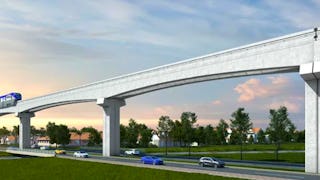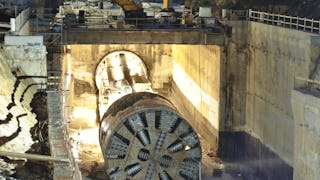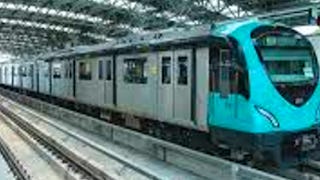This course covers the modules on Caverns, shafts, construction methods of underground stations, Underground station design methodology and underground station analysis. Beginning with in depth understanding of the types, uses and construction of caverns, it also covers shafts used for underground construction, construction practices in shafts . The different types of underground Metro stations, an overview of the modelling and analysis and construction practices of underground metro stations is also covered in this course. This comprehensive course equips learners with the knowledge and skills needed for efficient, safe, and successful underground metro projects and caverns. This course is majorly for consumption in the Indian subcontinent and the target audience are undergraduate and post graduate students, faculties and freshers who has entered the industry as young professionals.

3 days left: Get a Black Friday boost with $160 off 10,000+ programs. Save now.


Underground Metros Shafts and Caverns
This course is part of Construction Practices in Deep excavations and Tunnels Specialization

Instructor: Subject Matter Expert
Included with
Recommended experience
Skills you'll gain
Details to know

Add to your LinkedIn profile
6 assignments
See how employees at top companies are mastering in-demand skills

Build your subject-matter expertise
- Learn new concepts from industry experts
- Gain a foundational understanding of a subject or tool
- Develop job-relevant skills with hands-on projects
- Earn a shareable career certificate

There are 6 modules in this course
The "Caverns" module provides a comprehensive exploration of underground spaces, commencing with an introduction to caverns and their diverse applications. The module examines various cavern types, addressing crucial considerations for their construction. Learners gain insights into factors influencing the choice of cavern shape, and the design and construction of support systems for cavern stability. The construction process is detailed, emphasizing rock support techniques. The module guides the selection of numerical modeling software for effective design analysis and delves into the importance of continuous monitoring to ensure cavern stability. Through this holistic approach, participants acquire a well-rounded understanding of cavern engineering, covering theoretical aspects, practical construction considerations, and the application of advanced numerical tools for effective design.
What's included
10 videos1 assignment
The "Shafts" module offers a comprehensive exploration of these vital underground structures. It begins with an introduction to shafts and their diverse applications, spanning industries such as mining, civil engineering, and infrastructure. The module covers different types of shafts and details excavation techniques and construction methods for both raising and sinking operations. Emphasis is placed on the critical aspects of selecting excavation methods and support systems tailored to specific shaft requirements. By encompassing theoretical knowledge and practical applications, learners gain a well-rounded understanding of the construction and applications of shafts.
What's included
9 videos1 assignment
The "Construction of Metros" module provides a comprehensive exploration of underground station components and construction methods essential for metro systems. It initiates with an introduction to the components of underground stations, laying the foundation for understanding their intricate construction. The module delves into construction methods, emphasizing the Bottom-Up Methodology and the strategic selection of construction approaches. Practical applications are showcased, offering learners real-world insights into the implementation of construction methodologies for underground metro stations. By blending theoretical knowledge with practical applications, this module equips participants with the expertise needed to navigate the complexities of metro construction, ensuring efficient, safe, and successful projects in urban transportation infrastructure.
What's included
5 videos1 assignment
The "UG Stations Retaining Systems" module provides a comprehensive exploration of earth retaining structures in the context of underground stations. It begins with an understanding of underground stations and their configurations, followed by an in-depth analysis of various types of earth retaining structures. The module delves into the design of diaphragm walls, emphasizing their analysis. Learners will gain proficiency in the design of secant pile walls, guide walls, and the intricacies of strut and waler design. Capping beams, crucial for structural integrity, are also covered. By blending theoretical knowledge with practical design principles, this module equips participants with the skills needed to address the complexities of retaining systems in the construction of underground stations.
What's included
14 videos1 assignment
The "UG-Station Analysis" module provides a detailed exploration of the structural analysis considerations crucial for underground station design. Covering various aspects of load analysis, the module begins with an examination of codes of practice, dead loads, live loads, and superimposed dead loads. It further explores considerations related to earth and water loads, surcharge, seismic loads, and construction loads. The course encompasses load combinations and criteria for fire resistance. Soil springs are studied to understand soil-structure interaction. Practical applications involve the generation and interpretation of 2D and 3D models, enabling learners to proficiently analyze and assess structural responses in underground station projects. The module equips participants with the skills needed to adhere to industry standards and ensure the structural integrity of underground station construction
What's included
10 videos1 assignment
The UG station design module covers SOD restrictions & Element sizing for UG Stations, Floatation calculation, Structural Elements Clear cover & fire rating ,Design of D-wall of underground stations ,Design of Slabs(Base slab, concourse slab and roof slab) Design of Beam and column. This module equips the learners to design an underground metro station.
What's included
8 videos1 assignment
Earn a career certificate
Add this credential to your LinkedIn profile, resume, or CV. Share it on social media and in your performance review.
Instructor

Offered by
Explore more from Environmental Science and Sustainability
 Status: Free Trial
Status: Free TrialL&T EduTech
 Status: Free Trial
Status: Free TrialL&T EduTech
 Status: Free Trial
Status: Free Trial Status: Free Trial
Status: Free TrialL&T EduTech
Why people choose Coursera for their career





Open new doors with Coursera Plus
Unlimited access to 10,000+ world-class courses, hands-on projects, and job-ready certificate programs - all included in your subscription
Advance your career with an online degree
Earn a degree from world-class universities - 100% online
Join over 3,400 global companies that choose Coursera for Business
Upskill your employees to excel in the digital economy
Frequently asked questions
To access the course materials, assignments and to earn a Certificate, you will need to purchase the Certificate experience when you enroll in a course. You can try a Free Trial instead, or apply for Financial Aid. The course may offer 'Full Course, No Certificate' instead. This option lets you see all course materials, submit required assessments, and get a final grade. This also means that you will not be able to purchase a Certificate experience.
When you enroll in the course, you get access to all of the courses in the Specialization, and you earn a certificate when you complete the work. Your electronic Certificate will be added to your Accomplishments page - from there, you can print your Certificate or add it to your LinkedIn profile.
Yes. In select learning programs, you can apply for financial aid or a scholarship if you can’t afford the enrollment fee. If fin aid or scholarship is available for your learning program selection, you’ll find a link to apply on the description page.
More questions
Financial aid available,

